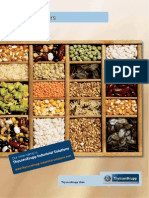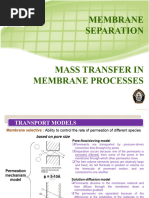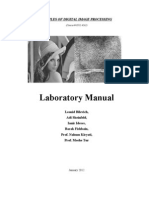07 Membrane Separation
Uploaded by
Ralph Evidente07 Membrane Separation
Uploaded by
Ralph EvidenteMembrane Separation
Engr. Elisa G. Eleazar
CHE135-1P: SEPARATION PROCESSES 1
Outline
Membrane
Membrane Transport in
Mechanism Shapes and Process Types
Materials Membranes
Modules
Learning Objectives
1. Explain the mechanism of Membrane Separation
2. Differentiate the membrane materials, shapes and modules
3. Explain the transport phenomenon in membranes
4. Differentiate the different process types
CHE135-1P: SEPARATION PROCESSES 2
Mechanism
Membrane
homogeneous, symmetric, charged,
an interface that separates the two phases and restricts heterogeneous asymmetric neutral
the transport of various chemical species through it
Membrane Separation
a feed consisting of two or more components is partially
separated by means of a semipermeable barrier
through which some species move faster than others
Characteristics
the two products are usually miscible
the separating agent is a semipermeable barrier
a sharp separation is often difficult to achieve
CHE135-1P: SEPARATION PROCESSES 3
Mechanism
Industrial Membrane Separation Processes
Reverse Osmosis Water and wastewater treatment
Dialysis Separation of nickel sulfate from sulfuric acid
Electrodialysis Electroplating wastewater treatment
Microfiltration Sterilization liquids and gases
Ultrafiltration Clarification of fruit juice
CHE135-1P: SEPARATION PROCESSES 4
Membrane Materials
From processed natural polymers An effective polymer membrane must possess high permeance
Cellulose and a high permeance ratio for the two species being separated.
Rubber
=
Synthetic polymers
long linear chain: polyethylene
=
branched chain: polybutadiene
three-dimensional, highly cross-linked structure:
phenol-formaldehyde Ni Molar transmembrane flux
moderately cross-linked structure: butyl rubber Permeance
PMi Permeability
Production of Synthetic Polymers
lm Membrane thickness
by condensation reactions
from monomers by free-radical or ionic-catalyzed
addition (chain reactions)
CHE135-1P: SEPARATION PROCESSES 5
Membrane Materials
A silica-glass membrane, 2-m thick with pores < 10 in diameter, has been developed for
separating H2 from CO at a temperature of 500F. From laboratory data, the membrane
permeabilities of H2 and CO, respectively, are 200,000 and 700 barrer, where the barrer, a common
unit for gas permeation, is defined by:
10
3
1 = 10
2
where cm3 (STP)/cm2-s refers to the volumetric transmembrane flux of the diffusing species in terms
of standard conditions of 0C and 1 atm; cm refers to the membrane thickness, and cmHg refers to
the transmembrane partial pressure driving force for the diffusing species.
If the transmembrane, partial-pressure driving forces for H2 and CO, respectively, are 240 psi and 80
psi, calculate the transmembrane fluxes in kmol/m2-s.
CHE135-1P: SEPARATION PROCESSES 6
Membrane Shapes and Modules
Types of Membranes Based on Structure Types of Membranes Based on Morphology
Symmetric (Isotropic) Assymetric (Anisotropic) Porous Dense
has similar structural composed of two or more have tiny pores or pore do not have pores;
composition and structural planes of non- networks partition diffusion
morphology at all positions identical composition or partition mechanism
morphology
CHE135-1P: SEPARATION PROCESSES 7
Membrane Shapes and Modules
Shapes
Flat, asymmetric or thin-
Tubular Hollow-fiber Monolithic
film composite sheet
1 m x 1 m x 200 m Diameter: 0.5 5 cm 4.2 m ID x 85 m OD x 1.2 m long Diameter: 0.3 0.6 cm
Dense layer: 500 5,000 up to 6 m long Dense skin: 0.1 1.0 m Mem layer: 20 40 mm
CHE135-1P: SEPARATION PROCESSES 8
Membrane Shapes and Modules
Modules
Spiral Wound
Plate and Frame Four-leaf Spiral Wound
CHE135-1P: SEPARATION PROCESSES 9
Membrane Shapes and Modules
Modules
Tubular
Hollow-fiber Monolithic
CHE135-1P: SEPARATION PROCESSES 10
Transport in Membranes
Restricted diffusion Solution-diffusion through
Bulk flow through pores Diffusion through pores
through pores dense membranes
CHE135-1P: SEPARATION PROCESSES 11
Transport in Membranes
the pore diameter is large compared to the molecular diameter and a pressure
difference exists across the membrane
Bulk Flow
Through generally undesirable because it is not permselective; no separation between
components occurs
Pores
mechanism of transfer through microporous membranes used for ultrafiltration
and microfiltration (separation is achieved by sieving)
Bulk flow of a liquid due to a pressure difference through an idealized straight, cylindrical pore;
2
= 0
32
v Flow velocity Assumptions:
Pore diameter Laminar flow
Parabolic velocity profile across the pore radius
Viscosity Newtonian fluid
L Length of the pore The mean free path of gas molecules is small compared
to the pore diameter
Po PL Pressure drop
CHE135-1P: SEPARATION PROCESSES 12
Transport in Membranes
Bulk Flow Through Pores But pores are not cylindrical and straight
[ ]
= 4
Membrane porosity with n number of pores [ ]
2
= [ ]
4
[ ]
Superficial fluid bulk flow flux (mass velocity) = 4
[ ]
[ ]
2 4
= = 0 = 0
32 128 4 Includes vol
= of pores
N Mass velocity
Membrane thickness = av Specific surface area
1
CHE135-1P: SEPARATION PROCESSES 13
Transport in Membranes
Bulk Flow Through Pores It is desired to pass water at 70F through a
supported, polypropylene membrane, with a
skin of 0.003 cm thickness and 35% porosity, at
Pore length is longer than membrane thickness the rate of 200 m3/m2-day. The pores can be
considered as straight cylinders of uniform
diameter equal to 0.2 micron. If the pressure on
Superficial fluid bulk flow flux (mass velocity) the downstream side of the membrane is 150
kPa, estimate the required pressure on the
3 upstream side of the membrane. The pressure
= = 2 2 0
2 1 drop through the support is negligible.
* = 0.001 Pa-s
CHE135-1P: SEPARATION PROCESSES 14
Transport in Membranes
occurs if fugacity, activity, chemical potential, concentration or partial pressure
Liquid differences exist across the membrane for the various components but the
Diffusion pressure is the same on both sides of the membrane so as not to cause bulk flow
in Pores
separation is achieved
Restrictive Factor: accounts for the effect of pore
If the feed mixture is a liquid of solvent and solutes i; diameter in causing interfering collisions of the diffusing
solutes with the pore wall when dm/dp exceeds 0.01
=
0 4
Dei Effective diffusivity
= 1 1
Concentration of i
Effective diffusivity Kr Restrictive factor
= 0 >
dm Molecular diameter
= dp Pore diameter Selectivity
, =
CHE135-1P: SEPARATION PROCESSES 15
Transport in Membranes
Liquid Diffusion in Pores
Beck and Shultz measured effective diffusivities of urea and different sugars, in aqueous solutions,
through microporous membranes of mica, which were especially prepared to give almost straight,
elliptical pores of almost uniform size. Based on the following data for a membrane and two solutes,
estimate transmembrane fluxes for the two solutes in g/cm2-s at 25C. Assume that the aqueous
solutions on either side of the membrane are sufficiently dilute that no multicomponent diffusional
effects are present.
Membrane Solutes
Thickness, m 4.24 Di x 106 Mol dia, ci0,
MW ciL, g/cm3
cm2/s g/cm3
Average pore diameter, 88.8
Urea 60 13.8 5.28 0.0005 0.0001
Tortuosity 1.1
-Dextrin 1135 3.22 17.96 0.0003 0.00001
Porosity 0.0233
CHE135-1P: SEPARATION PROCESSES 16
Transport in Membranes
hindered diffusion, resulting in an enhanced separation
Gas
Diffusion special case: the pore size and/or pressure is such that the mean free path of the
molecules is greater than the pore diameter
If the mixture on either side of a microporous membrane is a gas, and that the pressure and
temperatures on either side of the membrane are equal and the ideal gas law holds;
= 0 = 0
In the absence of a bulk-flow effect or restrictive diffusion;
1 cM Total concentration of gas
= 8 Knudsen diffusivity
1 + 1 =
Average molecule velocity
M Molecular weight
= = 4,850 DK Knudsen diffusivity
3
CHE135-1P: SEPARATION PROCESSES 17
Transport in Membranes
Gas Diffusion
When Knudsen flow predominates, selectivity is based on the permeability ratio for species A and B
1
2
=
A gas mixture of hydrogen and ethane is to be partially separated with a composite membrane having
a 1-m-thick porous skin with an average pore size of 20 and a porosity of 30%. The tortuosity can
be assumed to be 1.5. The pressure on either side of the membrane is 10 atm and the temperature is
100C. Estimate the permeabilities of the two components in barrers.
* At 100C, DH = DE = DH,E = 0.86/P cm 2/s
CHE135-1P: SEPARATION PROCESSES 18
Transport in Membranes
Solution- gas or liquid components absorb into the membrane at the upstream face, diffuse
Diffusion through the solid membrane and desorb at the downstream face
Through
Dense predominant mechanism for reverse osmosis (liquid), gas permeation (gas) and
Membranes pervaporation (liquid and vapor)
Liquid Mixtures Gas Mixtures
CHE135-1P: SEPARATION PROCESSES 19
Transport in Membranes
Solution-Diffusion Through Dense Membranes: Liquid Mixtures
Ficks Law
=
0
= 0
cio and cio are related by equilibrium partition coefficient =
0
0 = =
0
0 = =
CHE135-1P: SEPARATION PROCESSES 20
Transport in Membranes
Solution-Diffusion Through Dense Membranes: Gas Mixtures
Henrys Law
0
0 = =
0
0 = =
= 0
CHE135-1P: SEPARATION PROCESSES 21
Transport in Membranes
External Mass Transfer Resistances
Bulk Flow
= 0 = =
0
=
1 1
+ +
Diffusion Through Pores
= 0 = 0 =
=
1 1
+ +
CHE135-1P: SEPARATION PROCESSES 22
Transport in Membranes
External Mass Transfer Resistances
General Empirical Film-Model Correlation
0.33
= = = =
Flow Regime Flow Channel Geometry dH a b d
Turbulent, Re > 10,000 Circular tube 0.023 0.8 0
Rectangular channel 2
0.023 0.8 0
+
Laminar, Re < 2100 Circular tube 1.86 0.33 0.33
Rectangular channel 2
1.62 0.3 0.33
+
CHE135-1P: SEPARATION PROCESSES 23
Transport in Membranes
A dilute solution of solute A in solvent B is passed through a tubular membrane separator, where the
feed flows through the tubes. At a certain location, the solute concentrations are 5.0 102 3 and
1.5 102 3 , respectively on the feed and permeate sides. The permeance of the membrane for solute A is
given by the membrane vendor as 7.3 105 . If the tube side Reynolds number is 15,000, the feed-side
2
solute Schmidt number is 500, the diffusivity of the feed-side solute is 6.5 105 , and the inside diameter of
the tube is 0.5 cm, estimate the flux of the solute through the membrane if the mass transfer resistance on the
permeate side of the membrane is negligible.
CHE135-1P: SEPARATION PROCESSES 24
Process Types
CHE135-1P: SEPARATION PROCESSES 25
Process Types
CHE135-1P: SEPARATION PROCESSES 26
Process Types
Reverse Osmosis
Used for small particles
Molecular weight: < 100
Pore size: 2 10
Pressure: > 25 atm
Example: desalination
CHE135-1P: SEPARATION PROCESSES 27
Process Types
Microfiltration Ultrafiltration Nanofiltration
Molecular weight: > 100,000 Molecular weight: 103 - 105 Molecular weight: 200 1000
Pore size: > 1,000 Pore size: 20 1,000 Pore size: 5 to 20
Pressure: 1 to 50 psig Pressure: 10 to 100 psig Pressure: 40 to 200 psig
Surface filtration Size exclusion Assymetric
Symmetric Assymetric
Example: sterilization of drugs Example: filtration of proteins Example: filtration of peptides
Water Monovalent ions Multivalent ions Sugars, amino acids Proteins, polysaccharides Particulates, colloids, bacteria
CHE135-1P: SEPARATION PROCESSES 28
Process Types
Gas Permeation
The feed gas contains some low-MW species to be separated from small
amount of high-MW species at high pressure
Example: Recovery of methane from biogas
CHE135-1P: SEPARATION PROCESSES 29
Process Types
Pervaporation
The feed is a liquid mixture at a usually ambient pressure or elevated
high enough to maintain a liquid phase as the feed is depleted of
species A and B to produce the product retentate.
Example: dehydration of ethanol
CHE135-1P: SEPARATION PROCESSES 30
Process Types
Dialysis
The feed is a liquid, at pressure P1, containing solvent, solutes and/or
insoluble, but dispersed, colloidal matter. A sweet liquid or wash of
the same solvent is fed at pressure P2 to the other side of the
membrane.
Example: separation of nickel sulfate from sulfuric acid
CHE135-1P: SEPARATION PROCESSES 31
Process Types
Dialysis
The concentration difference of a solute across the membrane drives its
transport through the membrane. The solute flux is directly proportional to
the difference in solute concentration across the membrane and inversely
proportional to the thickness of the membrane.
CHE135-1P: SEPARATION PROCESSES 32
Process Types
Co-current Dialysis Counter-current Dialysis
C1
Feed concentration
C2
Product concentration
C3
Dialysing fluid
1 3 2 4 concentration 1 4 2 3
= =
3 4
ln 1 C4 ln 1
2 4 2 3
Dialysate
concentration
CHE135-1P: SEPARATION PROCESSES 33
Process Types
The figure below shows a completely mixed dialyser unit. Plasma having a glutamine concentration of 2
kg/m3 is pumped into the dialyser at a rate of 5 x 10-6 m3/s and water at a flow rate of 9 x 10-6 m3/s is used as
the dialysing fluid. If the overall mass transfer coefficient is 2 x 10-4 m/s and the membrane area is 0.05 m2,
calculate the steady state concentrations of glutamine in the product and dialysate streams. Assume that
there is no convective transport through the membrane.
CHE135-1P: SEPARATION PROCESSES 34
Outline
Membrane
Membrane Transport in
Mechanism Shapes and Process Types
Materials Membranes
Modules
Learning Objectives
1. Explain the mechanism of Membrane Separation
2. Differentiate the membrane materials, shapes and modules
3. Explain the transport phenomenon in membranes
4. Differentiate the different process types
CHE135-1P: SEPARATION PROCESSES 35
Membrane Separation
Engr. Elisa G. Eleazar
CHE135-1P: SEPARATION PROCESSES 36
You might also like
- Kinematics Important Questions and Solutions For JEE Main and AdvancedNo ratings yetKinematics Important Questions and Solutions For JEE Main and Advanced19 pages
- Small Animal Radiology and Ultrasound A Diagnostic Atlas and Text100% (3)Small Animal Radiology and Ultrasound A Diagnostic Atlas and Text728 pages
- Membrane Technology: By: Prof. Dr. Tien R. MuchtadiNo ratings yetMembrane Technology: By: Prof. Dr. Tien R. Muchtadi47 pages
- Desalination Technologies, 4th Level, ERE414, 2023, ChapterNo ratings yetDesalination Technologies, 4th Level, ERE414, 2023, Chapter49 pages
- Separation Process II Course Outline UTPNo ratings yetSeparation Process II Course Outline UTP4 pages
- Electrodialysis: Overview of Electrodialysis (ED) Principles of ED Components of ED Application and UsesNo ratings yetElectrodialysis: Overview of Electrodialysis (ED) Principles of ED Components of ED Application and Uses18 pages
- Membrane Separation and Reverse OsmosisNo ratings yetMembrane Separation and Reverse Osmosis19 pages
- Mass Transfer (Presentation) : Group MembersNo ratings yetMass Transfer (Presentation) : Group Members14 pages
- Caustic Recovery Using Membrane FiltrationNo ratings yetCaustic Recovery Using Membrane Filtration9 pages
- Lecture Notes-Bioreactor Design and Operation-1No ratings yetLecture Notes-Bioreactor Design and Operation-119 pages
- Properties, Synthesis & Applications: By: M.Wadah JawichNo ratings yetProperties, Synthesis & Applications: By: M.Wadah Jawich67 pages
- Nitrate Fertilisers: Rupp Industrial SolutionsNo ratings yetNitrate Fertilisers: Rupp Industrial Solutions20 pages
- Chapter 13 - Membrane Separation Processes100% (1)Chapter 13 - Membrane Separation Processes63 pages
- Groundwater Aeration Towers, Degasifiers, Air Strippers: Advanced Odor Removal SystemsNo ratings yetGroundwater Aeration Towers, Degasifiers, Air Strippers: Advanced Odor Removal Systems1 page
- Mass Transfer Study and Modeling of Gas-Liquid Membrane Contacting100% (1)Mass Transfer Study and Modeling of Gas-Liquid Membrane Contacting8 pages
- Lecture Notes 14 Introduction To Membrane Science and Technology 2019No ratings yetLecture Notes 14 Introduction To Membrane Science and Technology 201932 pages
- Deammonification For Cost-Effective Sidestream TreatmentNo ratings yetDeammonification For Cost-Effective Sidestream Treatment54 pages
- Membrane Filtration: Water and Wastewater Engineering (ECE4453) Group 1No ratings yetMembrane Filtration: Water and Wastewater Engineering (ECE4453) Group 130 pages
- CECO Filters - Ammonium Nitrate Applications ManualNo ratings yetCECO Filters - Ammonium Nitrate Applications Manual35 pages
- Fundamentals of Chemical Engineering Process Equipment DesignNo ratings yetFundamentals of Chemical Engineering Process Equipment Design6 pages
- Intelligen Inc. - SuperPro Designer Batch Process SimulatioNo ratings yetIntelligen Inc. - SuperPro Designer Batch Process Simulatio6 pages
- (J) FO Workshop Slide (Final Version) - SP - Edit - 2No ratings yet(J) FO Workshop Slide (Final Version) - SP - Edit - 227 pages
- Membrane Separation Processes: ReferencesNo ratings yetMembrane Separation Processes: References36 pages
- Meat Irradiation: Evidente, Ralph Carlo T. Loresca, Daniel Eldrei DNo ratings yetMeat Irradiation: Evidente, Ralph Carlo T. Loresca, Daniel Eldrei D6 pages
- Energy: Increased in Worldwide Consumption of Energy Has Led To A Search For New Energy Sources For The FutureNo ratings yetEnergy: Increased in Worldwide Consumption of Energy Has Led To A Search For New Energy Sources For The Future18 pages
- Umami: Evidente, Ralph Carlo Reyes, Carl SamuelNo ratings yetUmami: Evidente, Ralph Carlo Reyes, Carl Samuel11 pages
- Dosing Pump For Liquids: Fields of ApplicationNo ratings yetDosing Pump For Liquids: Fields of Application3 pages
- Kleppner (Introduction To Mechanics) (Errata)0% (1)Kleppner (Introduction To Mechanics) (Errata)3 pages
- CFC TERAMATE, A Korean Functional Material Manufacturer, Launched A Highly Transparent Antibacterial Nanodispersion ProductNo ratings yetCFC TERAMATE, A Korean Functional Material Manufacturer, Launched A Highly Transparent Antibacterial Nanodispersion Product2 pages
- Project 3 - Enamine Reactions 2-Acetylcyclohexanone100% (1)Project 3 - Enamine Reactions 2-Acetylcyclohexanone3 pages
- Solutions To Second Homework Assignment: ME 692 - Computational Fluid DynamicsNo ratings yetSolutions To Second Homework Assignment: ME 692 - Computational Fluid Dynamics5 pages
- UT Dallas Syllabus For Phys2326.501.09s Taught by Yuri Gartstein (Yxg037000)No ratings yetUT Dallas Syllabus For Phys2326.501.09s Taught by Yuri Gartstein (Yxg037000)5 pages
- Discrete Element Simulation of Crushable Soil: Géotechnique January 2003No ratings yetDiscrete Element Simulation of Crushable Soil: Géotechnique January 200310 pages
- 2 Refraction of Light: Practice 2.1 (p.51)No ratings yet2 Refraction of Light: Practice 2.1 (p.51)9 pages
- Nano Technology: Prof - DR P.Veeramani - Csir-Cecri100% (1)Nano Technology: Prof - DR P.Veeramani - Csir-Cecri44 pages















































































































